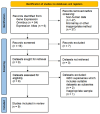Dopamine Receptors and TAAR1 Functional Interaction Patterns in the Duodenum Are Impaired in Gastrointestinal Disorders
- PMID: 39062162
- PMCID: PMC11274761
- DOI: 10.3390/biomedicines12071590
Dopamine Receptors and TAAR1 Functional Interaction Patterns in the Duodenum Are Impaired in Gastrointestinal Disorders
Abstract
Currently, there is a growing amount of evidence for the involvement of dopamine receptors and the functionally related trace amine-associated receptor, TAAR1, in upper intestinal function. In the present study, we analyzed their expression in the duodenum using publicly accessible transcriptomic data. We revealed the expression of DRD1, DRD2, DRD4, DRD5, and TAAR1 genes in different available datasets. The results of the gene ontology (GO) enrichment analysis for DRD2 and especially TAAR1 co-expressed genes were consistent with the previously described localization of D2 and TAAR1 in enteric neurons and secretory cells, respectively. Considering that co-expressed genes are more likely to be involved in the same biological processes, we analyzed genes that are co-expressed with TAAR1, DRD2, DRD4, and DRD5 genes in healthy mucosa and duodenal samples from patients with functional dyspepsia (FD) or diabetes-associated gastrointestinal symptoms. Both pathological conditions showed a deregulation of co-expression patterns, with a high discrepancy between DRDs and TAAR1 co-expressed gene sets in normal tissues and patients' samples and a loss of these genes' functional similarity. Meanwhile, we discovered specific changes in co-expression patterns that may suggest the involvement of TAAR1 and D5 receptors in pathologic or compensatory processes in FD or diabetes accordingly. Despite our findings suggesting the possible role of TAAR1 and dopamine receptors in functional diseases of the upper intestine, underlying mechanisms need experimental exploration and validation.
Keywords: DRD2; DRD4; DRD5; TAAR1; diabetic gastroparesis; dopamine; duodenum; functional dyspepsia; trace amines.
Conflict of interest statement
The authors declare no conflicts of interest. The funders had no role in the design of the study; in the collection, analyses, or interpretation of data; in the writing of the manuscript; or in the decision to publish the results.
Figures






Similar articles
-
Analysis of association between dopamine receptor genes' methylation and their expression profile with the risk of schizophrenia.Psychiatr Genet. 2013 Oct;23(5):183-7. doi: 10.1097/YPG.0b013e328363d6e1. Psychiatr Genet. 2013. PMID: 23851595
-
Functional Analysis of TAAR1 Expression in the Intestine Wall and the Effect of Its Gene Knockout on the Gut Microbiota in Mice.Int J Mol Sci. 2024 Dec 9;25(23):13216. doi: 10.3390/ijms252313216. Int J Mol Sci. 2024. PMID: 39684925 Free PMC article.
-
Postsynaptic D2 dopamine receptor supersensitivity in the striatum of mice lacking TAAR1.Neuropharmacology. 2015 Jun;93:308-13. doi: 10.1016/j.neuropharm.2015.02.010. Epub 2015 Feb 24. Neuropharmacology. 2015. PMID: 25721394
-
In-vivo pharmacology of Trace-Amine Associated Receptor 1.Eur J Pharmacol. 2015 Sep 15;763(Pt B):136-42. doi: 10.1016/j.ejphar.2015.06.026. Epub 2015 Jun 17. Eur J Pharmacol. 2015. PMID: 26093041 Review.
-
Trace amine-associated receptor 1: a multimodal therapeutic target for neuropsychiatric diseases.Expert Opin Ther Targets. 2018 Jun;22(6):513-526. doi: 10.1080/14728222.2018.1480723. Epub 2018 Jun 5. Expert Opin Ther Targets. 2018. PMID: 29798691 Review.
References
-
- Liu C.-Z., Feng X.-Y., Liu S., Zhang X.-L., Zhu J.-X. Synthesis and Metabolism of Gut Dopamine. In: Zhu J.-X., editor. Dopamine in the Gut. Springer; Singapore: 2021. pp. 25–51.
Grants and funding
LinkOut - more resources
Full Text Sources

